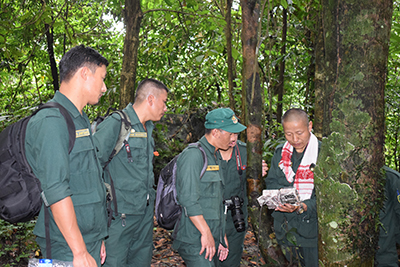
Picture courtesy: Nature Conservation Division
Bhutan now has a draft National Biodiversity Monitoring Protocol in place to monitor its wild biodiversity. The Biodiversity Monitoring Protocol basically is a guide or manual that outlines tools and methods to gather crucial information about plant and animal species, such as species diversity, habitat, threats and distribution patterns, among others. The development of the protocol is a first attempt to put in place a proper national-level biodiversity monitoring system in place.
Initiated by the Nature Conservation Division, biodiversity experts came together over the past few months to develop protocols for monitoring plant, mammal, fish, reptile and amphibian, bird and insect species. The protocol for different species were field tested and consolidated at a workshop in Gelephu recently. Some 45 forestry officials from across the country took part.
“We have very rich biodiversity and we do a lot of monitoring works in protected areas. For instance, we do a lot of biodiversity surveys during the management plan. But those are all surveys done in small pockets. We really don’t have a national-level data. With the help of the protocol, we will be able to get a systematic, coordinated and consolidated biodiversity data from across the country,” Tandin, the Senior Forestry Officer of Nature Conservation Division under DoFPS, said.
 The week-long workshop included rigorous field exercise, which involved visiting forests and rivers to record and identify plant and animal species. Jigme Tshelthrim Wangyal, the Deputy Chief Forestry Officer of Jigme Khesar Strict Nature Reserve (JKSNR) in Haa, led the herpetofauna or reptile and amphibian group.
The week-long workshop included rigorous field exercise, which involved visiting forests and rivers to record and identify plant and animal species. Jigme Tshelthrim Wangyal, the Deputy Chief Forestry Officer of Jigme Khesar Strict Nature Reserve (JKSNR) in Haa, led the herpetofauna or reptile and amphibian group.
“For us, the herpetofauna group, we don’t even have a baseline data. With this protocol now, we are expecting a baseline data. Once we have baseline data, we can work on it and see changes over the years like whether the species are disappearing or becoming more,” he said.
Besides determining status and tracking changes, biodiversity monitoring also helps to understand threats to species and their responses. Jigme TshelthrimWangyal says reptiles and amphibians, in fact, are used to study climate change.
“Frogs and toads are very sensitive to temperature and humidity because they depend on water bodies to live. They can indicate whether the climate is changing, or temperature is changing. So, we can use them to study climate change.”
The draft protocol will be handed to the Department of Forests and Park Services (DoFPS) for review and approval.
“After approval, the protocol needs to be institutionalised so that Bhutan has an annual biodiversity monitoring program. In order to effectively implement the biodiversity monitoring protocol, we will incorporate it into the Individual Work Plan,” Letro, the Senior Forestry Officer of Nature Conservation Division, said.
While Bhutan is well known for its rich biodiversity, there is no standard monitoring protocol in place. The Nature Conservation Division’s effort to come up with a protocol, therefore, is critical to ensuring the country’s wild biodiversity thrives.
However, the protocol alone is not enough. Regular wild biodiversity monitoring at the national level would entail a lot of costs. Capacity building of field staff, equipping forest divisions and park offices with necessary equipment and infrastructure, such as repository to store species specimen, is crucial to ensure successful biodiversity monitoring.
The protocol was developed through the National Adaptation Programme of Action (NAPA) phase III project, initiated and implemented by the government. It is supported by UNDP and funded by the Global Environment Facility.









